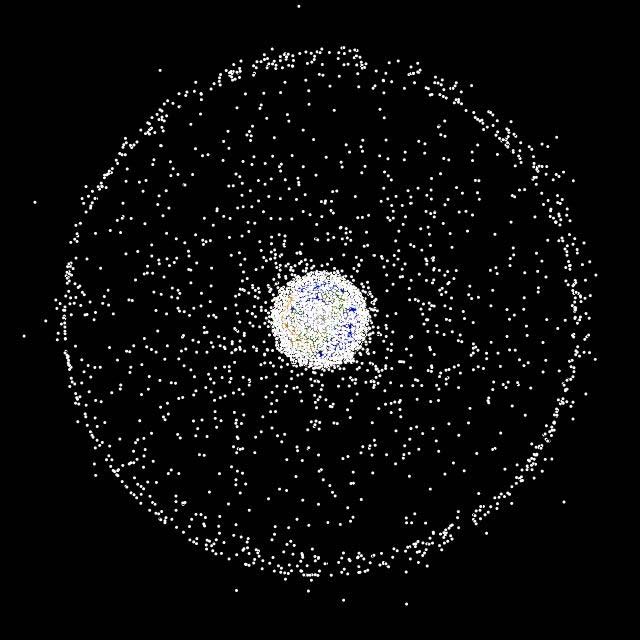Out There: Space Traffic Control System Needed

The orbital space around Earth has become a busy thoroughfare of satellites operated by several nations. The region is also littered with dead and dying satellites, plus bits of debris ranging from large and dangerous chunks to potentially deadly nuts and bolts and even hazardous chips of paint.
Just as airlines work under an air traffic control system, it's time for a space traffic management system, some experts say.
In fact, work has begun on a blueprint for a first step toward that goal: a civilian space situational awareness system.
Military and civilian cooperation
There are some 4,000 rocket bodies and satellites, dead or alive, orbiting Earth. In addition, more than 6,000 other large, observable and tracked bits of debris float around up there. More than 200,000 smaller bits bigger than 1 centimeter -- still potentially dangerous but not tracked -- are thought to be in orbit. Much of this material moves at 17,500 mph.
A Chinese anti-satellite test last year created a whopping new cloud of debris that experts called the most prolific and severe fragmentation in space ever.
Satellites and debris in low-Earth orbit can pose a threat to other satellites, space shuttles, and the International Space Station.
Breaking space news, the latest updates on rocket launches, skywatching events and more!
A recent meeting brought together hundreds of aerospace safety experts from America, Europe, Russia, and China to discuss all this. The International Association for the Advancement of Space Safety (IAASS) meeting was held October 21-23 in Rome.
The topic: Civil space situational awareness, or SSA.
Brian Weeden, Technical Consultant with the Secure World Foundation (SWF), a sponsor of the event, said until now SSA has generally only been talked about in a military context.
"SSA is extremely important for military space, but there is a significant need for SSA in civilian space as well," Weeden said. "This SSA system needs to work in an international context, much the same way as aviation does. But very few companies and States have the resources to fund and operate their own SSA network."
Global conversation
The conference has started a global conversation on the technology needed.
"Much of the data needed is already being collected by various actors, from scientific institutions to multinational companies to backyard satellite observers," Weeden said in a statement last week. "The difficulty is in breaking down the barriers between these disparate sources, making the different types and sources of data compatible, and distributing it in such a way as to protect the rights and privacy concerns of the different sources. It's definitely a challenge, but so far we haven't come across any insurmountable technical barriers."
Commercial companies who operate large, expensive communication satellites in the geostationary belt – a densely packed area 22,236 miles directly above the equator – have already recognized the importance of this and have started the process.
"Further, as military investment in space assets grow, it will be increasingly important to have a neutral, reliable source of SSA data for non-military actors," said Theresa Hitchens, Director of the Center for Defense Information in Washington, D.C.
Hitchens said a civil SSA structure could help ensure transparency and reduce tensions by providing data in an apolitical way.
"It seems to me that the effort by global satellite communication companies to develop better processes for sharing data among themselves and with governments is testimony to this need…as well as a solid first step," she said.
Up and running
T.S. Kelso, another conference participant, is a Senior Research Astrodynamicist for Analytical Graphics, Inc.'s Center for Space Standards and Innovation, located in Colorado Springs, Colorado. Kelso runs CelesTrak, an on-line satellite tracking tool that uses orbital data provided by U.S. military's North American Aerospace Defense Command (NORAD).
The analyst also offers Satellite Orbital Conjunction Reports Assessing Threatening Encounters in Space - or SOCRATES for short. This service provides regular information on pending conjunctions on orbit over the coming week. The goal is to help satellite operators avoid undesired close approaches through advanced mission planning.
Kelso is teamed with eight operators of satellites in geostationary Earth orbit (GEO), receiving orbital data directly from them for 124 satellites to establish SOCRATES-GEO. "We are able to use this data…to provide much better SSA for predicting and avoiding close approaches," he said.
To enhance overall satellite situational awareness, "we're encouraging as many satellite operators to participate as possible, since the more that participate, the better the overall SSA," Kelso said.
SWF's Weeden foresees a system where commercial entities and States voluntarily pool their SSA data – with information then made available to all participants.
"Our goal is to bring more participants into this system and expand it into other congested and high-value areas of Earth orbit, such as Sun-synchronous orbit," Weeden adds. "Eventually, such an international, civil SSA system might form the foundation for a global space traffic management system."
- Video - Space Tourist's Life Aboard ISS
- NASA Aims to Keep Moon's Skies Junk-Free
- Worrisome Debris Cloud Circles Earth

Space.com is the premier source of space exploration, innovation and astronomy news, chronicling (and celebrating) humanity's ongoing expansion across the final frontier. Originally founded in 1999, Space.com is, and always has been, the passion of writers and editors who are space fans and also trained journalists. Our current news team consists of Editor-in-Chief Tariq Malik; Editor Hanneke Weitering, Senior Space Writer Mike Wall; Senior Writer Meghan Bartels; Senior Writer Chelsea Gohd, Senior Writer Tereza Pultarova and Staff Writer Alexander Cox, focusing on e-commerce. Senior Producer Steve Spaleta oversees our space videos, with Diana Whitcroft as our Social Media Editor.
